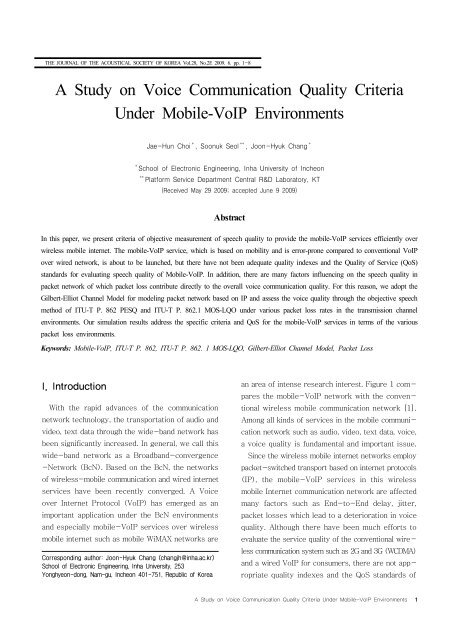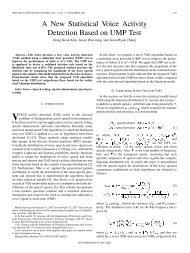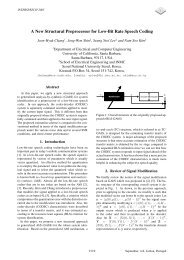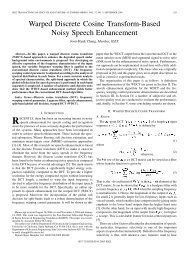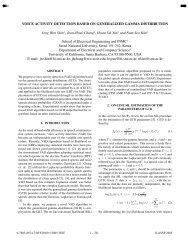A Study on Voice Communication Quality Criteria Under Mobile ...
A Study on Voice Communication Quality Criteria Under Mobile ...
A Study on Voice Communication Quality Criteria Under Mobile ...
Create successful ePaper yourself
Turn your PDF publications into a flip-book with our unique Google optimized e-Paper software.
THE JOURNAL OF THE ACOUSTICAL SOCIETY OF KOREA Vol.28, No.2E 2009. 6. pp. 1~8<br />
A <str<strong>on</strong>g>Study</str<strong>on</strong>g> <strong>on</strong> <strong>Voice</strong> Communicati<strong>on</strong> <strong>Quality</strong> <strong>Criteria</strong><br />
<strong>Under</strong> <strong>Mobile</strong>-VoIP Envir<strong>on</strong>ments<br />
Jae-Hun Choi * , So<strong>on</strong>uk Seol ** , Jo<strong>on</strong>-Hyuk Chang *<br />
* School of Electr<strong>on</strong>ic Engineering, Inha University of Inche<strong>on</strong><br />
** Platform Service Department Central R&D Laboratory, KT<br />
(Received May 29 2009; accepted June 9 2009)<br />
Abstract<br />
In this paper, we present criteria of objective measurement of speech quality to provide the mobile-VoIP services efficiently over<br />
wireless mobile internet. The mobile-VoIP service, which is based <strong>on</strong> mobility and is error-pr<strong>on</strong>e compared to c<strong>on</strong>venti<strong>on</strong>al VoIP<br />
over wired network, is about to be launched, but there have not been adequate quality indexes and the <strong>Quality</strong> of Service (QoS)<br />
standards for evaluating speech quality of <strong>Mobile</strong>-VoIP. In additi<strong>on</strong>, there are many factors influencing <strong>on</strong> the speech quality in<br />
packet network of which packet loss c<strong>on</strong>tribute directly to the overall voice communicati<strong>on</strong> quality. For this reas<strong>on</strong>, we adopt the<br />
Gilbert-Elliot Channel Model for modeling packet network based <strong>on</strong> IP and assess the voice quality through the obejective speech<br />
method of ITU-T P. 862 PESQ and ITU-T P. 862.1 MOS-LQO under various packet loss rates in the transmissi<strong>on</strong> channel<br />
envir<strong>on</strong>ments. Our simulati<strong>on</strong> results address the specific criteria and QoS for the mobile-VoIP services in terms of the various<br />
packet loss envir<strong>on</strong>ments.<br />
Keywords: <strong>Mobile</strong>-VoIP, ITU-T P. 862, ITU-T P. 862. 1 MOS-LQO, Gilbert-Elliot Channel Model, Packet Loss<br />
I. Introducti<strong>on</strong><br />
With the rapid advances of the communicati<strong>on</strong><br />
network technology, the transportati<strong>on</strong> of audio and<br />
video, text data through the wide-band network has<br />
been significantly increased. In general, we call this<br />
wide-band network as a Broadband-c<strong>on</strong>vergence<br />
-Network (BcN). Based <strong>on</strong> the BcN, the networks<br />
of wireless-mobile communicati<strong>on</strong> and wired internet<br />
services have been recently c<strong>on</strong>verged. A <strong>Voice</strong><br />
over Internet Protocol (VoIP) has emerged as an<br />
important applicati<strong>on</strong> under the BcN envir<strong>on</strong>ments<br />
and especially mobile-VoIP services over wireless<br />
mobile internet such as mobile WiMAX networks are<br />
Corresp<strong>on</strong>ding author: Jo<strong>on</strong>-Hyuk Chang (changjh@inha.ac.kr)<br />
School of Electr<strong>on</strong>ic Engineering, Inha University, 253<br />
Y<strong>on</strong>ghye<strong>on</strong>-d<strong>on</strong>g, Nam-gu, Inche<strong>on</strong> 401-751, Republic of Korea<br />
an area of intense research interest. Figure 1 compares<br />
the mobile-VoIP network with the c<strong>on</strong>venti<strong>on</strong>al<br />
wireless mobile communicati<strong>on</strong> network [1].<br />
Am<strong>on</strong>g all kinds of services in the mobile communicati<strong>on</strong><br />
network such as audio, video, text data, voice,<br />
a voice quality is fundamental and important issue.<br />
Since the wireless mobile internet networks employ<br />
packet-switched transport based <strong>on</strong> internet protocols<br />
(IP), the mobile-VoIP services in this wireless<br />
mobile Internet communicati<strong>on</strong> network are affected<br />
many factors such as End-to-End delay, jitter,<br />
packet losses which lead to a deteriorati<strong>on</strong> in voice<br />
quality. Although there have been much efforts to<br />
evaluate the service quality of the c<strong>on</strong>venti<strong>on</strong>al wireless<br />
communicati<strong>on</strong> system such as 2G and 3G (WCDMA)<br />
and a wired VoIP for c<strong>on</strong>sumers, there are not appropriate<br />
quality indexes and the QoS standards of<br />
A <str<strong>on</strong>g>Study</str<strong>on</strong>g> <strong>on</strong> <strong>Voice</strong> Communicati<strong>on</strong> <strong>Quality</strong> <strong>Criteria</strong> <strong>Under</strong> <strong>Mobile</strong>-VoIP Envir<strong>on</strong>ments 1
Fig. 1. Comparis<strong>on</strong> between the mobile-VoIP network and the<br />
current wireless mobile communicati<strong>on</strong> network by Ji-<br />
Hyung Han KT (2008) [1].<br />
speech quality for the <strong>Mobile</strong>-VoIP [2-4]. Therefore,<br />
the objective quality criteria and QoS standards<br />
for providing the mobile VoIP are inherently required.<br />
<strong>Voice</strong> quality measurement can be performed using<br />
subjective or objective methods. First, mean opini<strong>on</strong><br />
score (MOS) is usually used in subjective measure<br />
of voice quality recommended by the ITU-T P. 800<br />
[5]. The ITU-T P. 800 MOS evaluati<strong>on</strong> is reliable<br />
method for assessing the voice quality but difficult<br />
to be carried out due to time c<strong>on</strong>suming and expensive<br />
cost. Because of the these problems, a variety<br />
of objective methods have been proposed to provide<br />
the estimati<strong>on</strong> of the objective MOS such as the intrusive<br />
objective measurement of Perceptual Analysis<br />
/Measurement System (PAMS) [6], Perceptual Evaluati<strong>on</strong><br />
of Speech <strong>Quality</strong> (PESQ), ITU-T P. 862 [7]<br />
or n<strong>on</strong>intrusive techniques of ITU-T E-model [8]<br />
and ITU-T P. 563 [9]. In order to evaluate performances<br />
of the public switched teleph<strong>on</strong>e and internet<br />
network, the ITU-T E-model is mostly used to predict<br />
voice quality by computing the system parameters.<br />
Also, the E-model as the n<strong>on</strong>intrusive method is<br />
adopted to measure the voice quality for VoIP applicati<strong>on</strong>s<br />
in the internet network. But, the E-model is<br />
restricted to the cases which communicate another<br />
networks such as public switched teleph<strong>on</strong>e systems<br />
or current mobile communicati<strong>on</strong> networks by a handover.<br />
In particular, the E-model can not c<strong>on</strong>tinuously<br />
evaluate the network service quality when the handover<br />
occurs to the another networks under the <strong>Mobile</strong><br />
-VoIP envir<strong>on</strong>ments.<br />
In this paper, we present the objective speech<br />
quality criteria and QoS standards to provide mobile<br />
-VoIP services over wireless mobile internet network.<br />
To evaluate the voice quality under <strong>Mobile</strong>-VoIP<br />
envir<strong>on</strong>ments, we investigate impacts of speech<br />
codecs such as EVRC (2G), AMR (3G) and G.729<br />
annex A in terms of the various packet loss rates<br />
[10-12]. We adopt the Gilbert-Elliot Channel Model<br />
for modeling packet network based <strong>on</strong> IP network<br />
and obtain the objective MOS by introducing the<br />
ITU-T P. 862 PESQ and ITU-T P. 862.1 MOS<br />
-LQO which can linearly compare the PESQ raw data<br />
with the subjective MOS scores [13][14]. This<br />
paper is organized as follows: Secti<strong>on</strong> II briefly<br />
compare the PESQ method with the E-model technique<br />
for the <strong>Mobile</strong>-VoIP services. In Secti<strong>on</strong> III,<br />
we describe the ITU-T P. 862.1 MOS-LQO which<br />
is applicable to the <strong>Mobile</strong>-VoIP. Secti<strong>on</strong> IV presents<br />
the test results and specific bound lines for<br />
reliable voice quality. Finally, the c<strong>on</strong>clusi<strong>on</strong>s are<br />
drawn in Secti<strong>on</strong> V.<br />
II. The overview of objective measurement<br />
for the voice quality<br />
In general, the MOS method is broadly used to<br />
evaluate the subjective measure of voice quality in<br />
the teleph<strong>on</strong>e transmissi<strong>on</strong> systems. The MOS scores<br />
are obtained as an average opini<strong>on</strong> to denote the test<br />
results, where each listener present to the fivepoint<br />
scale from 1 to 5 associated with a definiti<strong>on</strong><br />
of voice quality; Excellent (5), Good (4), Fair (3),<br />
Poor (2), and Bad (1) [5]. Although the MOS method<br />
is internati<strong>on</strong>ally a reliable standard measurement of<br />
voice quality, the subjective MOS method has the<br />
inherent problems which are time c<strong>on</strong>suming, expensive<br />
cost, lack of the statistical reliability.<br />
In order to avoid the disadvantages of the MOS<br />
method, the objective measurement of voice quality<br />
2 THE JOURNAL OF THE ACOUSTICAL SOCIETY OF KOREA Vol.28, No.2E
has been developed such as the ITU-T P. 862<br />
PESQ, ITU-T G. 107 E-model, ITU-T P. 563, and<br />
PSQM [6-9]. The PESQ and E-model are most<br />
comm<strong>on</strong>ly used objective measurement method for<br />
voice quality in current VoIP systems. The E-model<br />
is the relevant technique that can be used for voice<br />
quality predicti<strong>on</strong> by computing the system parameters<br />
including packet loss, delay, jitter and codec<br />
extracted from the network. Since the E-model<br />
eventually c<strong>on</strong>siders the packet loss, delay and jitter,<br />
evaluati<strong>on</strong> of the voice quality for the other networks<br />
such as the switched teleph<strong>on</strong>e or current mobile<br />
communicati<strong>on</strong> network is restricted [8]. Also, there<br />
is a disadvantage that is impossible to c<strong>on</strong>tinuously<br />
evaluate the voice quality if the handover occurs<br />
under the <strong>Mobile</strong>-VoIP envir<strong>on</strong>ments.<br />
C<strong>on</strong>trary to the n<strong>on</strong>intrusive E-model method, the<br />
PESQ of the intrusive objective measurement can be<br />
used for evaluating the voice quality criteria and<br />
evaluati<strong>on</strong> standard indexes for the speech quality of<br />
the end-to-end since the PESQ method compares<br />
original reference input signal with degraded speech<br />
signal for the end-to-end user. Actually, the PESQ<br />
method has been used for measuring the current<br />
mobile communicati<strong>on</strong> network as voice quality<br />
evaluati<strong>on</strong> models based <strong>on</strong> the actual call quality<br />
[15][16]. For this reas<strong>on</strong>, the PESQ is more suitable<br />
than the E-model method under the <strong>Mobile</strong>-VoIP<br />
envir<strong>on</strong>ments. Since the original scores from -0.5 to<br />
4.5 of the PESQ must be identified with the MOS<br />
scores of the ITU-T P. 800, the ITU-T P. 862.1<br />
MOS-LQO of the estimated MOS scores from the<br />
PESQ raw data is provided. According to the mapping<br />
functi<strong>on</strong>, the PESQ scores are c<strong>on</strong>verted to the<br />
estimated MOS (MOS-LQO) which is the values<br />
from 1.02 to 4.56. MOS-LQO method is specifically<br />
described by the next secti<strong>on</strong>. Figure 2 depicts the<br />
relati<strong>on</strong>ships between MOS-LQS, MOS-LQO and<br />
MOS-LQE by the ITU-T P. 800.1 Recommendati<strong>on</strong><br />
[17]. As shown in Fig. 2, the system includes the<br />
devices, core network and c<strong>on</strong>necti<strong>on</strong> network under<br />
the mobile-VoIP service envir<strong>on</strong>ments. Since the<br />
PESQ method objectively measures the voice quality<br />
Fig. 2. ITU-T P. 800.1 relati<strong>on</strong>ship between some MOS qualifiers.<br />
of the speech in and out in the system, it is called<br />
the MOS-LQO. If the speech out results is subjectively<br />
evaluated by the listeners, it denotes the<br />
MOS-LQS (Listening <strong>Quality</strong> Subjective). In the E-<br />
model method, the estimated MOS scores is obtained<br />
through the comparis<strong>on</strong> of speech samples in the<br />
database and experimental results based <strong>on</strong> the<br />
ITU-T G. 107 and the extracted system parameters<br />
[8]. Note that the E-model does not use the actual<br />
speech signals. If the E-model c<strong>on</strong>siders the delay<br />
and echo, the estimated MOS is the MOS-CQE<br />
(C<strong>on</strong>versati<strong>on</strong>al <strong>Quality</strong> Estimated). Otherwise, the<br />
MOS scores of the E-model are classified MOS-<br />
LQE (Listening <strong>Quality</strong> Estimated).<br />
III. The call quality measurement based<br />
<strong>on</strong> the ITU-T P. 862.1 MOS-LQO under<br />
the <strong>Mobile</strong>-VoIP<br />
C<strong>on</strong>trary to the c<strong>on</strong>venti<strong>on</strong>al mobile communicati<strong>on</strong><br />
network, where the speech signals were processed<br />
in the circuit-switched networks, the <strong>Mobile</strong>-VoIP<br />
are provided with voice over wireless mobile Internet<br />
such as mobile WiMAX networks based <strong>on</strong> IP.<br />
The assessment of the voice quality for VoIP applicati<strong>on</strong>s<br />
is c<strong>on</strong>venti<strong>on</strong>ally c<strong>on</strong>ducted using the intrusive<br />
PESQ method or n<strong>on</strong>intrusive E-model method. Since<br />
the handover occurs under the <strong>Mobile</strong>-VoIP envir<strong>on</strong>ments,<br />
the E-model technique is not suitable<br />
for measuring the call quality of the end-to-end.<br />
In order to assess the listening quality of the<br />
A <str<strong>on</strong>g>Study</str<strong>on</strong>g> <strong>on</strong> <strong>Voice</strong> Communicati<strong>on</strong> <strong>Quality</strong> <strong>Criteria</strong> <strong>Under</strong> <strong>Mobile</strong>-VoIP Envir<strong>on</strong>ments 3
end-to-end, the PESQ method which is mostly used<br />
for c<strong>on</strong>venti<strong>on</strong>al VoIP systems based <strong>on</strong> the fixed<br />
internet network must be introduced. Although the<br />
PESQ algorithm provides the PESQ-MOS scores<br />
from -0.5 to 4.5 as above menti<strong>on</strong>ed in Secti<strong>on</strong> II,<br />
the PESQ-MOS is identified with the MOS scores by<br />
the ITU-T P. 800. Therefore, in this paper, we<br />
present the call quality criteria and standard indexes<br />
using the PESQ method and MOS-LQO by the<br />
ITU-T P. 862.1 Rec so that the estimated MOS<br />
scores are compared with the MOS values of the<br />
ITU-T P. 800 for the <strong>Mobile</strong>-VoIP services based<br />
<strong>on</strong> the packet networks in which the voice data is<br />
transported with IP. The voice quality in MOS-LQO<br />
is measured by c<strong>on</strong>verting the PESQ raw data with<br />
MOS-LQO (ITU-T P. 800.1) score so that voice<br />
assessment of the PESQ method allow a linear comparis<strong>on</strong><br />
with MOS (ITU-T P. 800). The ITU-T P.<br />
862.1 Rec provides a single mapping from raw P. 862<br />
scores to MOS-LQO. The mapping functi<strong>on</strong> is given<br />
as follows:<br />
IV. Experimental results<br />
The voice data in wireless mobile Internet based<br />
<strong>on</strong> the packet-switching is transported with IP. In<br />
order to simulate the packet network, we inherently<br />
adopt the Gilbert-Elliot Channel Model based <strong>on</strong> the<br />
two state Markov model where this model has two<br />
states, Good (G) and Bad (B). Gilbert packet loss<br />
model is illustrated in Fig. 4 [19]. In Fig. 4, state G<br />
represents a packet received without a packet loss<br />
and state B denotes for the packet loss. The probabilities<br />
associated with the transiti<strong>on</strong> between G<br />
and B states are P and Q where P is the probability<br />
of transiti<strong>on</strong> from G state to B state and Q is the<br />
probability of transiti<strong>on</strong> from B state to G state,<br />
respectively. According to the above menti<strong>on</strong>ed<br />
Gilbert packet model, the error probability BER<br />
generated by Gilbert Channel Model is given as<br />
follow:<br />
<br />
(2)<br />
<br />
<br />
<br />
∙ <br />
(1)<br />
where<br />
where denotes the mapped MOS-LQO score which<br />
should be within ±0.01 absolute of the curve according<br />
to the graph of the mapping functi<strong>on</strong> and is<br />
the PESQ raw data obtained by the ITU-T P. 862<br />
algorithm. In order for users to compare the PESQ<br />
raw data with the MOS-LQO, ITU-T P. 862.1 also<br />
provides the graph of the functi<strong>on</strong> in Fig. 3 [14].<br />
(3)<br />
is a coefficient for the correlati<strong>on</strong>s of the packet<br />
errors and of the burst or random characteristic of<br />
the channel. As the above menti<strong>on</strong>ed (3), ≈<br />
depicts a nearly random error channel, while ≈<br />
Fig. 3. ITU-T P. 862.1-P. 862 algorithm’s mapping functi<strong>on</strong>.<br />
Fig. 4. Gilbert-Elliot Channel Model.<br />
4 THE JOURNAL OF THE ACOUSTICAL SOCIETY OF KOREA Vol.28, No.2E
means a totally bursty channel [18].<br />
Combining (2) and (3), the transiti<strong>on</strong> probabilities<br />
of P and Q is given by:<br />
<br />
<br />
(4)<br />
<br />
<br />
<br />
<br />
(5)<br />
<br />
The channel could be either in good state G or in<br />
the bad state B, where the mean error probabilities<br />
of and are nearly <br />
and <br />
, respectively.<br />
In the simulati<strong>on</strong> envir<strong>on</strong>ments, we set the<br />
<br />
and <br />
. Therefore, The transiti<strong>on</strong> probabilities<br />
of (4) and (5) is represented such that<br />
(6)<br />
(7)<br />
Based <strong>on</strong> the Gilbert packet loss model, we evaluate<br />
the call quality of the end-to-end for the various<br />
speech codecs, where G.729A mostly used for VoIP<br />
applicati<strong>on</strong>, AMR (3G) and EVRC (2G), in terms of<br />
the variable packet loss rates using ITU-T G. 191<br />
STL (Software Tool Library) [19]. The PESQ method<br />
of objective measurement is c<strong>on</strong>ducted and the<br />
results are assessed with MOS-LQO by the ITU-T<br />
P. 862.1 Recommendati<strong>on</strong>.<br />
In the experiment, the channel is assumed to be<br />
performed by either random packet losses or burst<br />
packet losses. The random packet loss implies that<br />
the random packet loss is generated uniformly under<br />
random loss channel characteristic, while the burst<br />
packet loss occur c<strong>on</strong>tinuously for the c<strong>on</strong>secutive<br />
frames. In order to c<strong>on</strong>duct the simulati<strong>on</strong> in terms<br />
of the variable packet loss rates, the packet loss<br />
rates have the values from 1% to 50%. For the<br />
simulati<strong>on</strong>s, thirty test phrases, spoken by four male<br />
and four female speakers from the NTT database,<br />
were used. Each phrase was composed with two<br />
different 8-sec<strong>on</strong>d meaningful sentences. To assess<br />
the call quality of the speech codecs for the variable<br />
packet loss rates under the Gilbert-Elliot Channel<br />
Model, we establish the experimental envir<strong>on</strong>ments<br />
as shown in Fig. 5. Firstly, the input speech signal<br />
is encoded in the encoder and then the encoding<br />
bitstream files were passed through the Gilbert-<br />
Elliot Channel Model, where the encoding files with<br />
packet losses were generated. Sec<strong>on</strong>dly, the bitstream<br />
with or without packet losses was decoded<br />
at the near-end speech codecs. Finally, the decoding<br />
Table 2. The PESQ and MOS-LQO results of various speech<br />
codecs based <strong>on</strong> the Gilbert-Elliot Channel Model under<br />
random channel envri<strong>on</strong>ments.<br />
Fig. 5. Block diagram of experimental setup.<br />
Table 1. Relati<strong>on</strong>ship between the subjective MOS and user’s<br />
satisfacti<strong>on</strong>.<br />
MOS<br />
User Satisfacti<strong>on</strong><br />
4.3 Very Satisfied<br />
4.0 Satisfied<br />
3.6 Some Users Dissatisfied<br />
3.1 Many Users Dissatisfied<br />
2.6 Nearly All Users Dissatisfied<br />
1.0 Not Recommended<br />
error<br />
rates<br />
PESQ<br />
AMR EVRC G.729A<br />
MOS<br />
-LQO<br />
PESQ<br />
MOS<br />
-LQO<br />
PESQ<br />
MOS<br />
-LQO<br />
1% 3.459 3.484 3.364 3.352 3.429 3.450<br />
3% 3.244 3.179 3.014 2.847 3.269 3.220<br />
5% 2.094 2.692 2.814 2.560 3.112 2.989<br />
10% 2.655 2.353 2.162 1.789 2.827 2.576<br />
15% 2.261 1.893 1.894 1.570 2.593 2.268<br />
20% 2.073 1.716 1.732 1.462 2.389 2.025<br />
25% 1.920 1.593 1.585 1.376 2.280 1.905<br />
30% 1.782 1.495 1.387 1.285 2.136 1.765<br />
35% 1.681 1.434 1.229 1.230 2.009 1.658<br />
40% 1.613 1.399 1.150 1.207 1.928 1.597<br />
45% 1.492 1.336 1.082 1.187 1.809 1.513<br />
50% 1.369 1.284 1.011 1.170 1.682 1.431<br />
A <str<strong>on</strong>g>Study</str<strong>on</strong>g> <strong>on</strong> <strong>Voice</strong> Communicati<strong>on</strong> <strong>Quality</strong> <strong>Criteria</strong> <strong>Under</strong> <strong>Mobile</strong>-VoIP Envir<strong>on</strong>ments 5
Table 3. The PESQ and MOS-LQO results of various speech<br />
codecs based <strong>on</strong> the Gilbert-Elliot Channel Model under<br />
burst channel envri<strong>on</strong>ments.<br />
AMR EVRC G.729A<br />
error<br />
MOS<br />
MOS<br />
MOS<br />
PESQ<br />
PESQ<br />
PESQ<br />
rates<br />
-LQO<br />
-LQO<br />
-LQO<br />
1% 3.911 4.051 3.667 3.764 3.630 3.717<br />
3% 3.235 3.163 3.584 3.654 3.296 3.255<br />
5% 3.048 2.895 3.342 3.320 3.076 2.936<br />
10% 2.836 2.591 3.342 3.320 2.710 2.418<br />
15% 2.523 2.180 2.158 1.786 2.413 2.048<br />
20% 2.242 1.869 1.938 1.599 2.092 1.724<br />
25% 2.036 1.679 1.355 1.276 2.037 1.676<br />
30% 2.007 1.655 1.356 1.277 2.012 1.657<br />
35% 1.634 1.403 1.317 1.259 1.920 1.587<br />
40% 1.492 1.335 1.177 1.214 1.745 1.469<br />
45% 1.473 1.326 1.177 1.214 1.741 1.470<br />
50% 1.369 1.285 1.014 1.171 1.678 1.432<br />
files with packet losses are compared with the<br />
reference speech files without packet losses in the<br />
speech quality evaluati<strong>on</strong> block. In the speech quality<br />
evaluati<strong>on</strong> block as depicted in Fig. 5, the PESQ<br />
scores were obtained and c<strong>on</strong>verted to the MOS-<br />
LQO using mapping functi<strong>on</strong>.<br />
At first, we evaluated the call quality of the representative<br />
speech codecs based <strong>on</strong> the Gilbert<br />
-Elliot Channel Model for the packet losses from 1%<br />
to 50% under the random channel and the burst<br />
channel. The PESQ and MOS-LQO scores can be<br />
seen from Table 1 and 2. The MOS-LQO scores for<br />
AMR, EVRC and G.729A for the random channel<br />
characteristic are summarized in Table 2. In general,<br />
if the MOS is larger or equal to 4.0, it comm<strong>on</strong>ly<br />
represents acceptable satisfacti<strong>on</strong> and means toll<br />
quality. However, if MOS is smaller than 3.6 and<br />
larger than 3.1, some users are slightly satisfied but<br />
certain users could be dissatisfied. In Table 1, it can<br />
be seen the user satisfacti<strong>on</strong> relating the subjective<br />
MOS. According to Table 1, AMR and G.729A must<br />
have be smaller or equal to 3% packet losses to meet<br />
the QoS criteria under the <strong>Mobile</strong>-VoIP for the<br />
random channel characteristic envir<strong>on</strong>ments. C<strong>on</strong>trary<br />
to AMR and G.729A, EVRC should be higher to 3%<br />
packet losses.<br />
From Table 3, we can see that MOS-LQO scores<br />
for AMR, EVRC and G.729A for the burst channel<br />
characteristic are slightly different. EVRC is robust<br />
Table 4. MOS-LQO results of the male versus female for<br />
AMR speech codec based <strong>on</strong> the Gilbert-Elliot Channel<br />
Model under random and burst channel envri<strong>on</strong>ments.<br />
AMR<br />
Random channel envri<strong>on</strong>emts Burst channel envir<strong>on</strong>ments<br />
error<br />
rates<br />
Male Female Male Female<br />
1% 3.723 3.246 4.203 3.898<br />
3% 3.453 2.905 3.346 2.981<br />
5% 3.008 2.376 3.059 2.731<br />
10% 2.650 2.055 2.736 2.447<br />
15% 2.104 1.682 2.329 2.030<br />
20% 1.895 1.537 2.019 1.720<br />
25% 1.735 1.450 1.789 1.570<br />
30% 1.608 1.382 1.753 1.557<br />
35% 1.540 1.329 1.476 1.330<br />
40% 1.501 1.296 1.406 1.263<br />
45% 1.417 1.255 1.398 1.255<br />
50% 1.355 1.214 1.356 1.213<br />
Table 5. MOS-LQO results of the male versus female for<br />
EVRC speech codec based <strong>on</strong> the Gilbert-Elliot Channel<br />
Model under random and burst channel envri<strong>on</strong>ments.<br />
EVRC<br />
Random channel envri<strong>on</strong>emts Burst channel envir<strong>on</strong>ments<br />
error<br />
rates<br />
Male Female Male Female<br />
1% 3.528 3.175 3.972 3.555<br />
3% 2.956 2.737 3.843 3.466<br />
5% 2.662 2.459 3.488 3.152<br />
10% 1.832 1.746 3.488 3.152<br />
15% 1.616 1.523 1.796 1.775<br />
20% 1.501 1.423 1.601 1.597<br />
25% 1.431 1.321 1.277 1.276<br />
30% 1.318 1.252 1.277 1.277<br />
35% 1.258 1.203 1.264 1.255<br />
40% 1.231 1.183 1.227 1.201<br />
45% 1.206 1.168 1.227 1.201<br />
50% 1.187 1.153 1.189 1.154<br />
in terms of the higher packet losses whose loss rate<br />
is ≥10%. We can c<strong>on</strong>clude that MOS-LQO for AMR,<br />
EVRC and G.729A should be at least lower or equal<br />
to 3% packet loss rates in terms of the QoS for<br />
<strong>Mobile</strong>-VoIP. Also, in Table 4 and 6, we analyzed<br />
the characteristic for the MOS-LQO in terms of the<br />
male and female, respectively. Since the pitch period<br />
6 THE JOURNAL OF THE ACOUSTICAL SOCIETY OF KOREA Vol.28, No.2E
Table 6. MOS-LQO results of the male versus female for<br />
G.729A speech codec based <strong>on</strong> the Gilbert-Elliot Channel<br />
Model under random and burst channel envri<strong>on</strong>ments.<br />
G.729A<br />
Random channel envri<strong>on</strong>emts Burst channel envir<strong>on</strong>ments<br />
error<br />
rates<br />
Male Female Male Female<br />
1% 3.616 3.283 3.918 3.516<br />
3% 3.435 3.005 3.525 2.986<br />
5% 3.210 2.769 3.138 2.733<br />
10% 2.764 2.388 2.583 2.253<br />
15% 2.486 2.049 2.190 1.907<br />
20% 2.211 1.837 1.836 1.613<br />
25% 2.082 1.728 1.778 1.574<br />
30% 1.924 1.606 1.759 1.556<br />
35% 1.804 1.512 1.693 1.481<br />
40% 1.741 1.454 1.567 1.370<br />
45% 1.639 1.387 1.579 1.361<br />
50% 1.528 1.334 1.533 1.331<br />
most comm<strong>on</strong>ly used AMR (3G), EVRC (2G), G.729A<br />
(VoIP applicati<strong>on</strong>s) by introducing the PESQ of the<br />
ITU-T P. 862 and MOS-LQO of the ITU-T P.<br />
862.1.<br />
From the experimental results, it can be seen that<br />
the packet loss rates should be at least higher to 3%<br />
packet loss under the random and burst channel<br />
characteristics to meet the QoS of the <strong>Mobile</strong>-VoIP.<br />
Also, since the MOS-LQO of the male is higher than<br />
the female’s MOS-LQO, methods to enhance the<br />
female’s voice quality such as the voice engine should<br />
be employed at the network providing the mobile<br />
-VoIP services. The PESQ scores and MOS-LQO<br />
presented in this paper can be used broadly as the<br />
criteria and QoS standards for the <strong>Mobile</strong>-VoIP<br />
services since there are not adequate call quality<br />
indexes for the <strong>Mobile</strong>-VoIP services.<br />
of female is different with the male, the MOS-LQO<br />
results are affected by speech codecs which are<br />
encoding and decoding with voice data of the male<br />
and female. The pitch period of the female is slightly<br />
faster than the pitch period of male’s voice.<br />
Presumable, the female’s voice data is determined to<br />
be sensitive for the packet losses. Comparing the<br />
MOS-LQO of the male with the female, male’s<br />
MOS-LQO is a difference from 0.1 to 0.4. Therefore,<br />
the mobile-VoIP services should be c<strong>on</strong>sidering the<br />
above menti<strong>on</strong>ed results which male’s MOS-LQO is<br />
more higher than the female’s MOS-LQO.<br />
IV. C<strong>on</strong>clusi<strong>on</strong>s<br />
In this paper, we have presented a criteria and the<br />
QoS standards for objective measurement of speech<br />
quality required to provide mobile-VoIP services<br />
over wireless mobile Internet such as mobile WiMAX<br />
networks in terms of the variable packet loss rates<br />
for the various speech codecs. For the simulati<strong>on</strong> of<br />
the <strong>Mobile</strong>-VoIP network based <strong>on</strong> IP, we adopt the<br />
Gilbert-Elliot Channel Model and evaluate the performance<br />
of the representative speech codecs which<br />
Acknowledgnent<br />
This work was partly supported by ETRI SoC<br />
Industry Promoti<strong>on</strong> Center and This work was partly<br />
supported by the IT R&D program of MKE/IITA<br />
[2008-F-045-01]<br />
References<br />
1. 이은곤, “모바일 인터넷전화 발전추세, 시장동인 및 시사점,” 정보통신<br />
정책 연구원, 20권, 8호, 1-25쪽, 2008.<br />
2. L. Ding et al., “Performance study of objective voice quality<br />
measures in VoIP,” in Proc. IEEE Symp. <strong>on</strong> Comput. Commun., pp.<br />
197-202, July 2007.<br />
3. A. Kurittu et al., “Applicati<strong>on</strong> and verificati<strong>on</strong> of the objective<br />
quality assessment method according to ITU recommendati<strong>on</strong><br />
series ITU-T P.862,” J. Audio Eng. Soc., vol. 54, no. 12, pp.<br />
1189-1202, Dec. 2006.<br />
4. L. Sun and E. C. Ifeachor, “Performance study of objective voice<br />
quality measures in VoIP,” IEEE Trans. <strong>on</strong> Multimedia, vol. 8, no.<br />
4, pp. 809-820, Aug. 2006.<br />
5. ITU-T Rec. P. 800, “Teleph<strong>on</strong>e transmissi<strong>on</strong> quality. Methods for<br />
objective and subjective assessment of quality; methods for<br />
subjective determinati<strong>on</strong> of transmissi<strong>on</strong> quality,” Internati<strong>on</strong>al<br />
Telecommunicati<strong>on</strong> Uni<strong>on</strong>, Telecommunicati<strong>on</strong>s Standardizati<strong>on</strong><br />
Sector (ITU-T), pp. 24-25 Geneva, Switzerland (1996).<br />
6. A. W. Rix and M. P. Hollier, “The perceptual analysis measurement<br />
system for robust end-to-end speech quality assess-<br />
A <str<strong>on</strong>g>Study</str<strong>on</strong>g> <strong>on</strong> <strong>Voice</strong> Communicati<strong>on</strong> <strong>Quality</strong> <strong>Criteria</strong> <strong>Under</strong> <strong>Mobile</strong>-VoIP Envir<strong>on</strong>ments 7
ment,” in Proc. IEEE ICASSP, vol. 3, pp. 1515-1518, June 2000.<br />
7. ITU-T Rec. P. 862, “Perceptual evaluati<strong>on</strong> of speech quality<br />
(PESQ), an objective method for end-to-end speech quality<br />
assessment of narrowband teleph<strong>on</strong>e networks and speech<br />
codecs,” Feb. 2001.<br />
8. ITU-T Rec. G. 107, “The E-Model, a computati<strong>on</strong>al model for use<br />
in transmissi<strong>on</strong> planing,” March 2005.<br />
9. ITU-T Rec. P.563, “Single-ended method for objective speech<br />
quality assessment in narrow-band teleph<strong>on</strong>y applicati<strong>on</strong>s,” May<br />
2004.<br />
10. R. Salami, C. Laflamme, B. Bessette, and J. P. Adoul, “ITU-T<br />
G.729 Annex A: reduced complexity 8kb/s CS-ACELP codec for<br />
digital simultaneous voice and data,” IEEE Commun. Mag., vol. 35<br />
pp. 56-63, Sept. 1997.<br />
11. 3GPP TS 26.090 V5.0.0, AMR speech codec; Transcoding<br />
functi<strong>on</strong>s, June 2002.<br />
12. TIA/EIA/IS-127, Enhanced variable rate codec, speech service<br />
opti<strong>on</strong>3 for wideband spread spectrum digital systems, 1997.<br />
13. M. Mushkin and I. Bar-David, “Capacity and coding for the<br />
Gilbert-Elliot channels,” IEEE Trans. Inform. Theory, vol. 35, no. 6,<br />
pp. 1277-1290, Nov. 1989.<br />
14. ITU-T Rec. P. 862.1, “Mapping functi<strong>on</strong> for transforming P.862 raw<br />
result scores to MOS-LQO”, Nov. 2003.<br />
15. M. J. Ho and A. Mostafa, “AMR call quality measurement based <strong>on</strong><br />
ITU-T P.862.1 PESQ-LQO,” in Proc. 64th IEEE Vehicular<br />
Technology C<strong>on</strong>ference, pp. 1-5, Sep. 2006.<br />
16. Z. Qiao, L. Sun, and E. C. Ifeachor, “Case study of PESQ<br />
performance in live wireless mobile VoIP envir<strong>on</strong>ments,” in<br />
Pers<strong>on</strong>al, Indoor and <strong>Mobile</strong> Radio Communicati<strong>on</strong>s 19th Inernati<strong>on</strong>al<br />
Symposium <strong>on</strong>, pp. 15-18, Sep. 2008.<br />
17. ITU-T Rec. P. 800. 1, “Mean opini<strong>on</strong> score (MOS) terminology,”<br />
July 2006.<br />
18. ITU-T Rec. G. 191, “Software tools for speech and audio coding<br />
standardizati<strong>on</strong>,” Nov. 2000.<br />
【Profile】<br />
∙ Jae-Hun Choi<br />
∙ So<strong>on</strong>uk Seol<br />
∙ Jo<strong>on</strong>-Hyuk Chang<br />
Jae-Hun Choi received the BS degrees in<br />
electr<strong>on</strong>ic engineering from Inha University,<br />
Inche<strong>on</strong>, Korea, in 2007 and he is working<br />
toward the MS degree in electr<strong>on</strong>ic engineering,<br />
at Inha University, Inche<strong>on</strong>, Korea. His research<br />
interests include speech reinforcement, speech<br />
enhancement processing, and audio coding.<br />
So<strong>on</strong>uk Seol received his B.S. in Informati<strong>on</strong><br />
and Communicati<strong>on</strong> Engineering from the Korea<br />
University of Technology and Educati<strong>on</strong> in 1998,<br />
and M.S. and Ph.D. in Computer Science from<br />
Korea Advanced Institute of Science and Technology,<br />
Daeje<strong>on</strong>, Korea, in 2000 and 2004,<br />
respectively. From 1998 he was also a visiting<br />
researcher at the Protocol Engineering Center in<br />
Electr<strong>on</strong>ics and Telecommunicati<strong>on</strong>s Research<br />
Institute (ETRI) until October 1999. Currently, he<br />
is with the Central R&D Laboratory at KT, as a<br />
senior researcher. His research interests include<br />
mobile VoIP/IPTV, mobile computing, QoS network,<br />
and protocol engineering.<br />
Jo<strong>on</strong>-Hyuk Chang received the BS degree in<br />
electr<strong>on</strong>ics engineering from Kyungpook Nati<strong>on</strong>al<br />
University, Daegu, Korea in 1998 and the MS<br />
and PhD degrees in electrical engineering from<br />
Seoul Nati<strong>on</strong>al University, Korea, in 2000 and<br />
2004, respectively. From March 2000 to April<br />
2005, he was with Netdus Corp., Seoul, as a<br />
chief engineer. From May 2004 to April 2005, he<br />
was with the University of California, Santa Barbara,<br />
in a postdoctoral positi<strong>on</strong> to work <strong>on</strong> adaptive<br />
signal processing and audio coding. In May<br />
2005, he joined Korea Institute of Science and<br />
Technology, Seoul, as a Research Scientist to<br />
work <strong>on</strong> speech recogniti<strong>on</strong>. Currently, he is an<br />
assistant professor in the School of Electr<strong>on</strong>ic<br />
Engineering at Inha University, Inche<strong>on</strong>, Korea.<br />
His research interests are in speech coding,<br />
speech enhancement, speech recogniti<strong>on</strong>, audio<br />
coding, and adaptive signal processing.<br />
8 THE JOURNAL OF THE ACOUSTICAL SOCIETY OF KOREA Vol.28, No.2E


